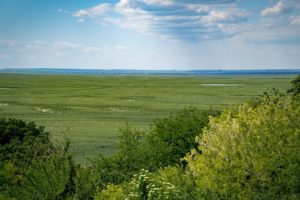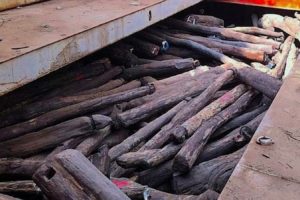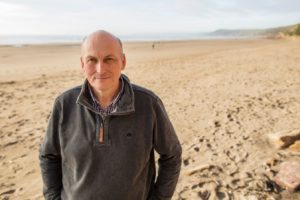As a student in forestry school, Peter Wohlleben was trained to look at trees exclusively as an economic commodity. But after joining a German forestry agency and managing a community forest, he soon became disillusioned with practices like clear-cutting, chemical use, and mechanical harvesting that put short-term profits before sustainability.
Wohlleben was eventually hired by the local mayor to look after the same forest in an eco-friendly way. Today, he manages the forest without using insecticides or heavy machinery, and the trees are harvested by hand and hauled out by horses. He also has started a “living gravestone” project in which townspeople pay the equivalent of the commercial value of an ancient tree to have their ashes interred at its base. The woodland has gone from a money-losing operation to a profitable one.
In an interview with Yale Environment 360, Wohlleben, author of The Hidden Life of Trees, discusses how trees are sophisticated organisms that live in families, support their sick neighbors, and have the capacity to make decisions and fight off predators. He has been criticized for anthropomorphizing trees, but Wohlleben, 52, maintains that to succeed in preserving our forests in a rapidly warming world, we must start to look at trees in an entirely different light.
_____
Yale Environment 360: You write in your book: “When I began my life as a forester, I knew as much about the hidden life of trees as a butcher knows about animals.”
Peter Wohlleben: Forestry students are taught how to harvest wood, what machines to use, how to sharpen the blade of a chainsaw, how to sell the timber, what price to expect — that’s about it. As a young forester I was told to make clear-cuts, to use insecticides, and so on. I thought— “Wait, I am someone who wants to protect nature, and here I am being asked to destroy it!”
I visited some other districts that were operating in an eco-friendly way, and I thought, that’s the way woods should be managed. But the problem is I was still thinking of trees as a commodity, as something to sell, not as living beings. I had to learn from the people of the community where my forest is located how to take a closer look at trees, to see them as unique individuals. I also started reading the latest scientific research that began to present me with a new picture of trees as highly sensitive and social beings.
e360: Social beings?
Wohlleben: We all learn in school that evolution advances by pitting each individual against every other in the struggle for survival. As a forester, I learned that trees are competitors that struggle against each other for light, for space. But we are now learning that individuals of a species are actually working together, they are cooperating with one another.
e360: How exactly do trees cooperate with one another?
Wohlleben: One thing is that mother trees suckle their children, they feed the young tree just enough sugars produced by its own photosynthesis to keep it from dying. Trees in a forest of the same species are connected by the roots, which grow together like a network. Their root tips have highly sensitive brain-like structures that can distinguish whether the root that it encounters in the soil is its own root, the root of another species, or the roots of its own species. If it encounters its own kind, I don’t know if scientists yet know how this happens, but we have measured with radioactive-marked sugar molecules that there is a flow from healthy trees to sick trees so that they will have an equal measure of food and energy available.
“Parts of the forest that grew naturally were 3 degrees C cooler than those managed by humans.”
e360: How do the healthy trees that feed their sick companions benefit?
Wohlleben: If sick trees die, they fall, which open gaps in the canopy. The climate becomes hotter and drier and the environment becomes worse for the trees that remain. In the forest I manage, students from Aachen University did a study that shows that the parts of the forest that grew naturally were 3 degrees C cooler than those that are managed and disturbed by humans.
The world is trying to limit warming from climate change to 2 degrees, but undisturbed forests can do even better than that. Forests create their own microclimate. When we thin forests, the temperature rises, the humidity goes down, evaporation increases, and all the trees begin to suffer. So trees have a stake in supporting one another to keep all members of the community healthy.
e360: You tell one amazing story in the book about trees keeping neighboring stumps alive.
Wohlleben: This one beech tree was cut four to 500 years ago by a charcoal maker, but the stump is still alive — we found green chlorophyll under the thick bark. The tree has no leaves to create sugars, so the only explanation is that it has been supported by neighboring trees for more than four centuries. I made this discovery myself, and later learned that other foresters have observed this happening as well.
e360: Are there other ways that trees help each other?
Wohlleben: We know that trees also exchange information. When one tree is attacked by insects, we can measure electrical signals that pass through the bark and into the roots and from there into fungi networks in the soil that alert nearby trees of the danger. The trees pay for this service by supplying the fungi with sugars from their photosynthesis. And the fungi in turn protect their host trees from attacks by other dangerous species of fungi and contamination by heavy metals.
Trees also send chemical signals through the air when they are attacked by insects. Nearby trees receive these messages and have time to prepare their defenses. Scientists like Suzanne Simard [who teaches forestry at the University of British Columbia in Vancouver] have labeled this amazing web of communication the Wood Wide Web.
e360: You have also written that trees remember their experiences?
Wohlleben: We had a heavy drought here. In subsequent years, the trees that had suffered through the drought consumed less water in the spring so that they had more available for the summer months. Trees make decisions. They can decide things. We can also say that a tree can learn, and it can remember a drought its whole life and act on that memory by being more cautious of its water usage.
e360: You’ve said that there are “friendships” between trees. What is the evidence for that?
Wohlleben: In about one in 50 cases, we see these special friendships between trees. Trees distinguish between one individual and another. They do not treat all other trees the same. Just today, I saw two old beeches standing next to each other. Each one was growing its branches turned away from the other rather than toward each other, as is more usually the case. In this way and others, tree friends take care of each other. This kind of partnership is well known to foresters. They know that if you see such a couple, they are really like a human couple; you have to chop down both if you chop one down, because the other will die anyway.
“Plants process information just as animals do, but for the most part they do this much more slowly.”
e360: You speak about trees as if they had personalities.
Wohlleben: Trees have just as much character as humans do. They also exercise independent judgments, which can differ. If trees lose their leaves too early, they many not produce enough food for a long winter. If they keep them on too long, they may get caught in an early snowstorm and the weight of the snow can break their branches. Some trees of the same species and age living right next to each other shed their leaves weeks before their neighbors. I’m not sure why some choose to do this earlier and others later, but it shows that there really are differences of character that we can’t easily account for.
e360: You have been criticized for attributing emotions to trees. Scientists usually avoid such language.
Wohlleben: We humans are emotional animals. We feel things, we don’t just know the world intellectually. So I use words of emotion to connect with people’s experience. Science often takes these words out, but then you have a language people can’t relate to, that they can’t understand. That’s one reason most scientific research has so little impact on people. If you only write technically about “biochemical processes,” people would quickly get bored and stop reading. We have been viewing nature like a machine. That is a pity because trees are badly misunderstood.
e360: How so?
Wohlleben: We just see them as oxygen producers, as timber producers, as creators of shade. I always ask people, “Who would think of, say, elephants in such terms?” We don’t look at elephants just as commodities or as mechanical and insentient objects. We recognize them as marvelous beings. On the other hand, nobody thinks about the inner life of trees, the feelings of these wonderful living beings.
e360: Plants are not generally thought to possess consciousness.
Wohlleben: We have this essentially arbitrary caste system for living beings. We say plants are the lowest caste, the pariahs because they don’t have brains, they don’t move, they don’t have big brown eyes. Flies and insects have eyes, so they are a bit higher, but not so high as monkeys and apes and so on. I want to remove trees from this caste system. This hierarchical ranking of living beings is totally unscientific. Plants process information just as animals do, but for the most part they do this much more slowly. Is life in the slow lane worth less than life on the fast track?
Perhaps we create these artificial barriers between humans and animals, between animals and plants, so that we can use them indiscriminately and without care, without considering the suffering that we are subjecting them to.
e360: How would understanding trees better change the way we manage forests?
Wohlleben: Humans are weakening ecosystems by indiscriminately cutting timber. We destroy tree social structures, we destroy their ability to react to climate change. We end up with individuals that are in a bad shape and susceptible to bark beetles, which can only infest trees that are already sick. A tree that is healthy can get rid of them. So the beetle is winning because we have degraded ecosystems to the point where they are unable to respond effectively to threats. Here in Germany, we have planted spruces to replace the beech trees. It is now too dry and warm for spruce, so those forests are failing in large parts of our country. It’s because we have planted the wrong species for the climate. We need to let nature heal itself and come back to balance with broadleaf species that are natural to our region, like oaks and beeches, which will help to cool the forests down and can survive climate change without too much harm.
“Faster growth makes trees less healthy and more susceptible to illnesses.”
e360: Do we need to manage forests at all?
Wohlleben: We are told that forests and woodlands need management, but it is just plantations that need management because they are unstable systems that can be destroyed by storms, by insects, by fire. It’s like a farm with hundreds of acres of corn. It is highly likely that insects or fungi will kill these plants because there is just one species. It’s the same thing with monoculture tree plantations. Natural systems, with a variety of species, are much more resilient.
e360: Managed forests and planted forests tend to space trees farther apart to encourage growth and prevent competition between the trees. Is this a good idea?
Wohlleben: Well, that is one mistake introduced by foresters. While it is true that trees may grow faster when we remove their comrades, because more sunlight means more photosynthesis, they actually grow too quickly for their own good. Trees should grow very slowly in the first 200 years, which we can call their youth. If they grow too fast in the beginning, they will waste all their energy in the rapid growth and will be out of breath, exhausted, and die early. It is similar to industrial meat production where a pig, for example, is fed too much so that it grows prematurely and in five or six months it can be sold and slaughtered. But the animals are unhealthy.
People on their home plots make the same mistake: They cut down some trees to encourage the growth of others. That would be like a family where they shoot the parents to give the kids more space. You slaughter their mother and the young trees will grow very fast, but they will be unhealthy and have short lives.
e360: Trees are growing faster now because of more CO2 in the air. Is that a good thing?
Wohlleben: Not at all. In Germany now, for example, trees are growing 30 percent faster than decades ago. But as I’ve said, faster growth makes trees less healthy and more susceptible to illnesses. The wood is also of lower quality, so the price we get for it is going down. The cells of these fast growing trees actually become bigger and more susceptible to fungi. A little wound can open them to rot, which kills them.
e360: Can foresters help protect forests from climate change and other environmental threats? I understand that in your forest, you still do things the old fashioned way.
Wohlleben: That’s right, we use horse-drawn carts to remove the wood. In between the trees, we don’t use any heavy machinery, which compresses the soil up to two meters deep and pushes the air out and makes it less able to soak up the water in winter that the trees need to use for growth in the spring.
e360: So the low-tech methods are actually more cost effective?
Wohlleben: Yes, they are working well all over the world — in the Amazon, even in the U.S, some forest owners are working with these methods. We recommend growing only tree species that are natural to the area. I also advise not to make any clear cuts, don’t kill the mother trees that are protecting their children, leave the families intact. Don’t use heavy machinery and cut out pesticides and other toxic chemicals that kill off beneficial insects and microorganisms in the soil. These are the keys to maintaining a successful and long-lived forest.




